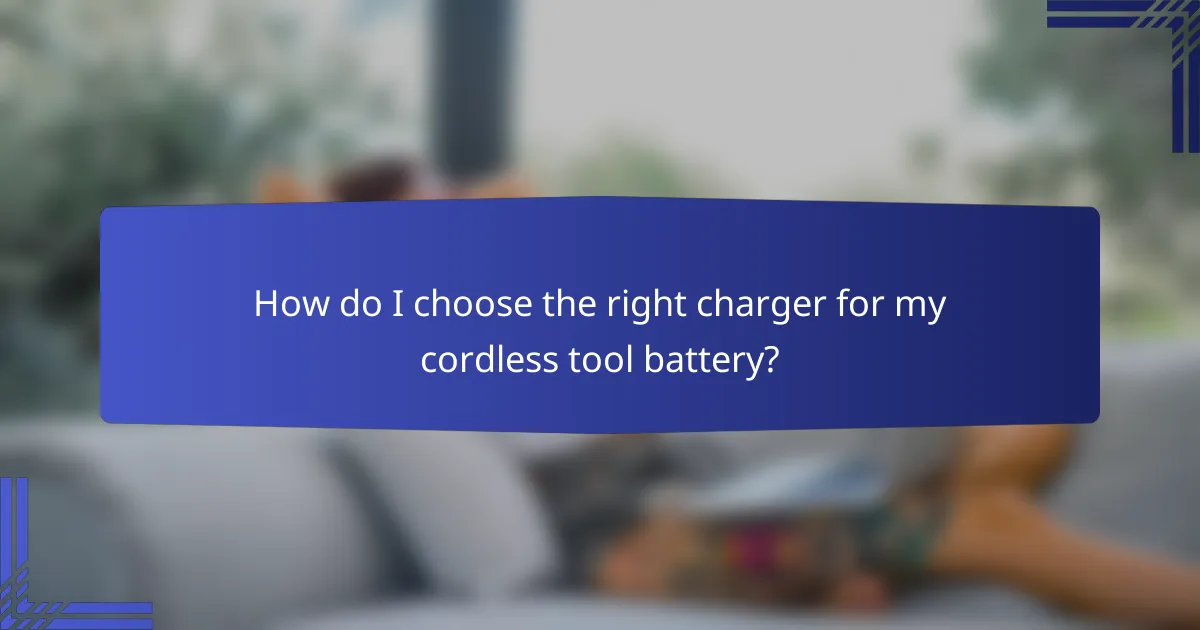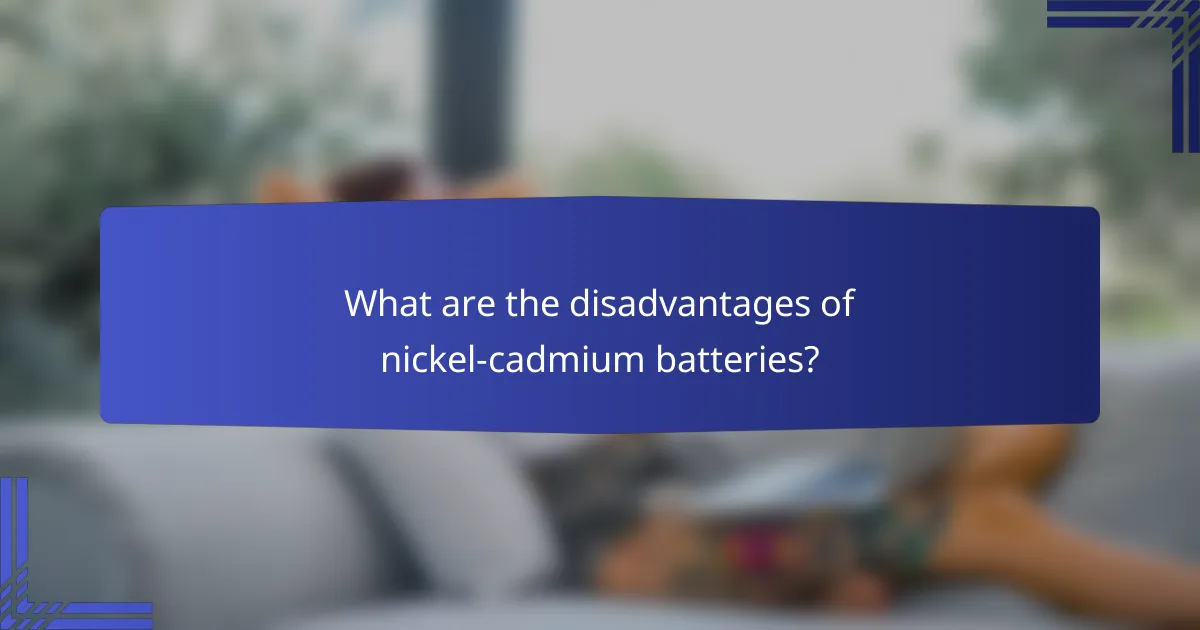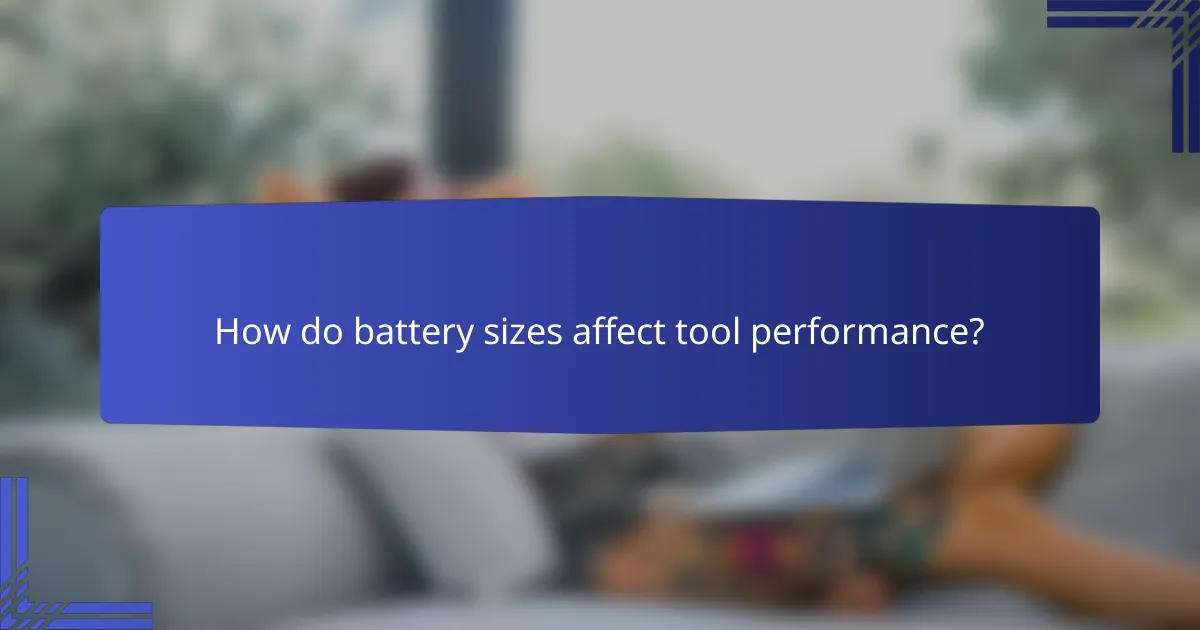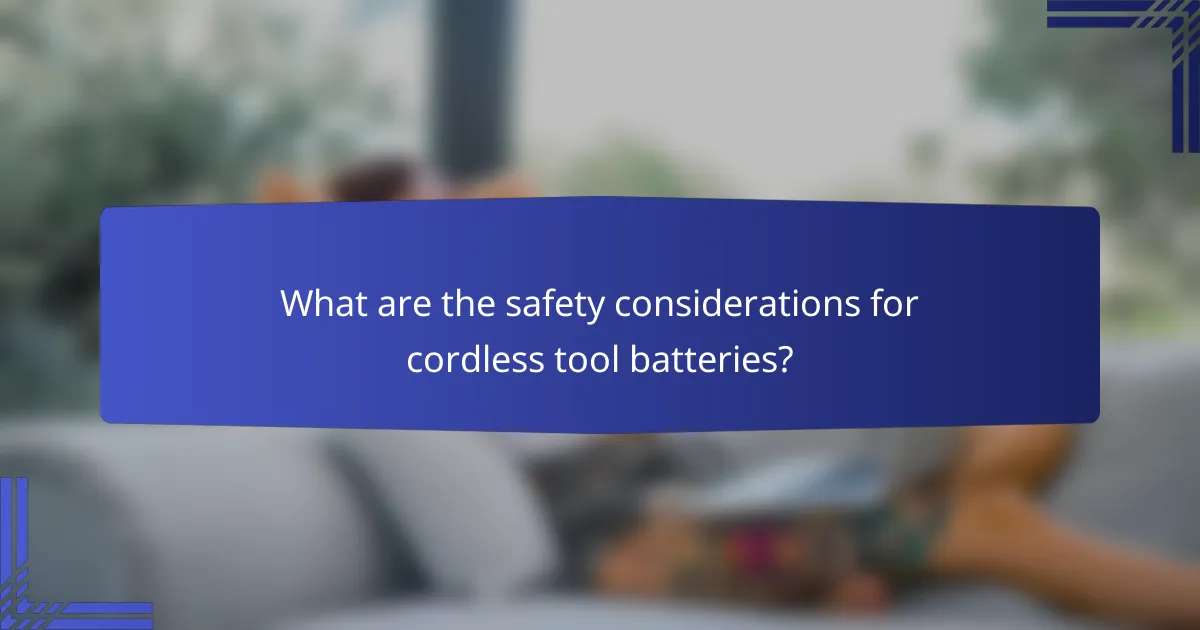When selecting a cordless tool battery, it’s important to consider the various types available, such as lithium-ion, nickel-cadmium, and nickel-metal hydride, each with unique benefits. Choosing the right charger is equally crucial; it should match the battery’s voltage, amp-hour rating, and type to ensure optimal performance and longevity.

What are the best cordless tool battery types for home use?
The best cordless tool battery types for home use include lithium-ion, nickel-cadmium, and nickel-metal hydride batteries. Each type has its own advantages and considerations, making it essential to choose the right one based on your specific needs and usage patterns.
Lithium-ion batteries
Lithium-ion batteries are the most popular choice for cordless tools due to their high energy density and lightweight design. They typically offer longer run times and faster charging compared to other types, making them ideal for frequent use.
When selecting lithium-ion batteries, consider their voltage and capacity, which can range from 12V to 60V or more. Look for features like built-in protection circuits to prevent overheating and overcharging, enhancing safety and longevity.
Nickel-cadmium batteries
Nickel-cadmium (NiCd) batteries are known for their durability and ability to perform well in extreme temperatures. They are less expensive than lithium-ion batteries but tend to have a lower energy density, resulting in shorter run times.
One drawback of NiCd batteries is the memory effect, which can reduce their capacity if not fully discharged before recharging. Regular maintenance, such as complete discharges, can help mitigate this issue and prolong battery life.
Nickel-metal hydride batteries
Nickel-metal hydride (NiMH) batteries offer a middle ground between lithium-ion and nickel-cadmium options. They provide better energy density than NiCd batteries and are less prone to the memory effect, making them a reliable choice for many users.
NiMH batteries typically have a voltage range similar to NiCd batteries, but they may require specific chargers. Be sure to check compatibility with your tools and consider their environmental impact, as they are generally more eco-friendly than NiCd batteries.

How do I choose the right charger for my cordless tool battery?
To choose the right charger for your cordless tool battery, ensure it matches the battery’s voltage, amp-hour rating, and type. Selecting the correct charger will optimize battery performance and lifespan, preventing damage and inefficiencies.
Match voltage specifications
Voltage specifications are crucial when selecting a charger. Most cordless tool batteries operate at specific voltages, typically ranging from 12V to 60V. Using a charger with a voltage that does not match your battery can lead to inadequate charging or even battery damage.
Check the battery label for its voltage rating, and ensure the charger you choose has the same rating. For example, if your battery is rated at 18V, opt for an 18V charger to ensure compatibility.
Consider amp-hour ratings
Amp-hour (Ah) ratings indicate the battery’s capacity and how long it can run before needing a recharge. Chargers are often rated by their output current, which can affect charging time. A charger with a higher output current will typically charge the battery faster.
For instance, if you have a 2Ah battery, a charger rated at 2A will fully charge it in about one hour. However, using a charger with a significantly higher output may not always be advisable, as it could lead to overheating or reduced battery lifespan.
Check compatibility with battery type
Different battery chemistries, such as lithium-ion, nickel-cadmium, or nickel-metal hydride, require specific chargers. Using the wrong charger can cause safety hazards or battery failure. Always verify that the charger is designed for your battery’s chemistry.
For example, lithium-ion batteries often require smart chargers that can manage charging cycles and prevent overcharging. Ensure the charger you select explicitly states compatibility with your battery type to avoid potential issues.

What are the advantages of lithium-ion batteries?
Lithium-ion batteries offer several advantages, making them a popular choice for cordless tools. Their efficiency, longevity, and lightweight nature contribute to improved performance and user experience.
Longer lifespan
Lithium-ion batteries typically have a longer lifespan compared to other battery types, often lasting several years with proper care. They can endure hundreds of charge cycles without significant degradation, which means they can maintain their capacity over time.
To maximize lifespan, avoid deep discharges and store the batteries at moderate temperatures. Regularly using and charging them can help keep the battery healthy and extend its usability.
Faster charging times
One of the key benefits of lithium-ion batteries is their faster charging capabilities. Many lithium-ion chargers can fully recharge a battery in about one to three hours, significantly reducing downtime during projects.
This quick turnaround is especially beneficial for professionals who rely on their tools throughout the day. Always use the manufacturer-recommended charger to ensure optimal charging speed and safety.
Lightweight design
Lithium-ion batteries are generally lighter than their nickel-cadmium or lead-acid counterparts, making tools easier to handle and maneuver. This lightweight design helps reduce fatigue during extended use, enhancing overall productivity.
When selecting cordless tools, consider the weight of the battery in relation to the tool’s design. A well-balanced tool with a lightweight battery can improve comfort and control, especially in demanding applications.

What are the disadvantages of nickel-cadmium batteries?
Nickel-cadmium (NiCd) batteries have several disadvantages that can impact their performance and environmental footprint. Key issues include memory effect, which reduces capacity over time, and environmental concerns due to the toxic nature of cadmium.
Memory effect issues
The memory effect in nickel-cadmium batteries occurs when they are repeatedly charged after being partially discharged. This phenomenon can lead to a significant reduction in usable capacity, as the battery “remembers” the lower charge level and fails to utilize its full potential.
To mitigate memory effect issues, it is advisable to fully discharge NiCd batteries periodically before recharging. This practice can help maintain their capacity and prolong their lifespan.
Environmental concerns
Nickel-cadmium batteries pose serious environmental risks due to the presence of cadmium, a toxic heavy metal. Improper disposal can lead to soil and water contamination, making it crucial to recycle these batteries according to local regulations.
Many regions have strict guidelines for the disposal of NiCd batteries, often requiring them to be taken to designated recycling facilities. Users should check local laws to ensure compliance and minimize environmental impact.

How do battery sizes affect tool performance?
Battery sizes significantly influence tool performance by determining both runtime and weight. Larger batteries typically provide longer usage times but can also add considerable heft to the tool, affecting maneuverability and ease of use.
Impact on runtime
The runtime of cordless tools is directly linked to battery size. Larger batteries, often rated in amp-hours (Ah), can store more energy, allowing tools to operate longer between charges. For instance, a 5Ah battery may last twice as long as a 2Ah battery under similar conditions.
When selecting a battery, consider the type of tasks you will perform. For heavy-duty applications, opting for a larger battery can prevent interruptions for recharging, while lighter tasks may not require as much capacity.
Influence on tool weight
Battery size affects the overall weight of the tool, which can impact user comfort and control. A larger battery can make a tool heavier, potentially leading to fatigue during extended use. For example, a tool with a 5Ah battery may weigh significantly more than one with a 2Ah battery.
When choosing a battery size, balance the need for runtime with the importance of tool weight. If you frequently work overhead or in tight spaces, a lighter tool may enhance your efficiency and reduce strain.

What are the safety considerations for cordless tool batteries?
When using cordless tool batteries, safety is paramount to prevent accidents and ensure longevity. Key considerations include proper handling, storage, and charging practices to mitigate risks such as overheating, short-circuiting, and chemical leaks.
Proper handling and storage of batteries
Always handle cordless tool batteries with care. Avoid dropping or puncturing them, as physical damage can lead to leaks or fires. Store batteries in a cool, dry place, away from direct sunlight and extreme temperatures, ideally between 20°C and 25°C (68°F and 77°F).
Ensure that batteries are kept out of reach of children and pets. Use battery cases or protective covers to prevent accidental short-circuiting when storing multiple batteries together.
Charging practices for safety
Use only the charger specified by the manufacturer for your cordless tool batteries. Mismatched chargers can lead to overheating and potential battery failure. Always charge batteries on a non-flammable surface and avoid leaving them unattended while charging.
Monitor the charging process; if a battery becomes excessively hot or starts to swell, disconnect it immediately and allow it to cool down. Regularly inspect chargers and batteries for signs of wear or damage.
Signs of battery failure
Be vigilant for signs that a cordless tool battery may be failing. Common indicators include reduced runtime, unusual swelling, or leaking fluids. If you notice any of these symptoms, discontinue use and dispose of the battery according to local regulations.
Many regions have specific guidelines for battery disposal, often requiring recycling at designated facilities. Check local waste management resources to ensure safe and environmentally friendly disposal practices.
